
Their white coats reflecting some of the most intense sunlight on Earth, the Arabian oryx (Oryx leucoryx; in Arabic, al-maha) can endure months without drinking, drawing moisture only from grazing, can detect the slightest rain far over the horizon and can walk as far as 100 kilometers in a day—qualities that have given it a near-mythic reputation.
A fingernail moon hung over the table-flat desert as Salah al-Mahdhoury, my biologist guide, and I are served dates and fresh fruit by Shaykh Muhammad bin Thamna al-Harsusi, one of the leaders of the Harasis tribe of central Oman. We rest on cushions and talk into the night over spiced tea and unsweetened coffee about the Arabian oryx, the long-horned white antelope that is symbolic to many Omanis. “This is the original place for the oryx,” the shaykh tells us. Members of his family and others join amiably in the conversation.
“Oryx think like human beings in organizing themselves. The leaders take shifts at the head of the herd.” It feels like a recounting of knowledge accumulated over generations. “The Harasis are caretakers. This is the meaning of the word,” the shaykh continues. “But despite all the promises, we cannot see the future, because the future is not in our hands.”
Since 1972, when the last wild oryx was shot in Oman, the sultanate has taken a leading role in regional attempts to save the species from extinction. The focus of its efforts has been largely here on this stony, semi-arid plain of karst limestone covering much of central Oman, known as the Jiddat al-Harasis. Here,
beginning in 1979, oryx were bred and released into the Arabian Oryx Sanctuary, a vast unfenced area the size of Massachusetts or Belgium. By 1996, two years after being named a World Heritage Site by the United Nations Educational, Scientific and Cultural Organization (UNESCO), the sanctuary was home to more than 450 free-roaming oryx, and the project’s success was acclaimed worldwide: The oryx, it seemed, was safe.
 |
| MATTHEW TELLER (2) |
| Above: An unofficial “national animal,” oryx commonly appear as emblems and logos in Oman and throughout the Gulf region—here on a newspaper masthead. Below: Named a World Heritage Site in 1994, Oman’s Arabian Oryx Sanctuary was about the size of Belgium. |
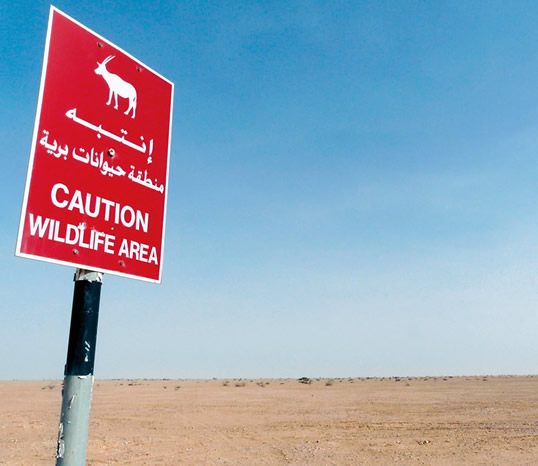 |
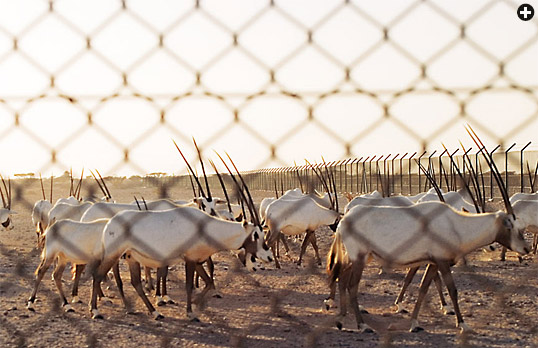 |
| ANNA McKIBBEN |
| Poachers reduced the population of Oman’s huge, unfenced sanctuary from 450 animals in 1996 to just 65 in 2007, leading to the fencing of today’s far smaller, heavily guarded reserve. There are now 260 oryx in it. |
Yet as Mohammed Shobrak points out, “most of the countries starting out on rein-troductions have the big picture—it’s all about conservation, bringing animals back to the wild—but they don’t have a detailed plan. So you start to see problems developing after a few years.” Shobrak is a biologist at Taif University and a consultant to Saudi Arabia’s National Commission for Wildlife Conservation and Development (NCWCD), which coordinates the kingdom’s oryx conservation.
In hindsight, it is perhaps too easy to see how the Omani decision to train and em-ploy guards, rangers and guides from only a single tribe—the Harasis—might have been likely to raise hackles among the neighboring Janaba, pastoralists and fisherfolk along the coastal lands to the east, whose population of 15,000 greatly outnumbers the 4500 Harasis.
Eager to exploit this tribal rift were unscrupulous animal collectors, mostly from the Gulf region. From 1996 onward, they offered the Janaba cash to poach oryx—as much as $20,000 for a live female. With only eight rangers charged with patrolling the huge, unfenced reserve, the oryx became unprotectable.
In less than a decade, the herds were decimated. Some animals died from injuries or stress during attempted captures; others were found dead, limbs trussed, dumped in the desert by fleeing poachers. Many, though, were taken and sold alive, mostly to private menageries.
By 2007, only 65 oryx remained, only four of them females. That year, an Omani royal decree reduced the Arabian Oryx Sanctuary by 90 percent to a size that could be guarded. The international press
lambasted Oman, and UNESCO delisted the sanctuary as a World Heritage Site—the first time that had been done.
“Oman chose to take the site off the UNESCO list,” explains Andrew Spalton, who is adviser for conservation of the environment for the royal court and a world authority on oryx. “There is talk of the [human] population of central Oman going from 2000 to 200,000. These changes are huge, and the concept of having oryx in the wild has not kept up. The idea of free-ranging wild herds is finished.”
Now, virtually all Oman’s oryx are gathered into a fenced enclosure of four square kilometers (1.5 sq mi), where they are
protected by police patrols armed with automatic weapons. Despite this defeat, Oman is not giving up.
“All our issues are socioeconomic,” says Spalton. “If I could do this again, I would place much heavier emphasis on the balance of communities.”
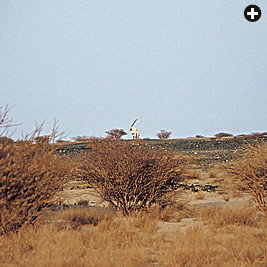 |
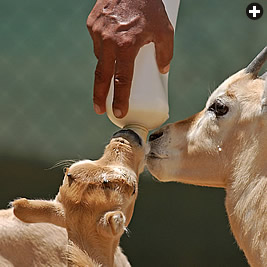 |
| Left: MATTHEW TELLER; Right: DIGSA KIFLE / NWRC |
| Left: The oryx “is part of the wealth of our community,” says Shaykh Muhammad. Right: To stamp out the tuberculosis that affects oryx in the wild, the nwrc bottle-feeds captive-born animals and raises them to maturity, breeds them and then releases their offspring—two generations removed from infection—in reserves. |
Oman’s sobering experience has conservationists across the region re-examining their approaches. In Saudi Arabia, Robbie Robinson is director of the King Khalid Wildlife Research Center, north of Riyadh. In Saudi Arabia, he says, oryx roam the Empty Quarter in the unfenced Uruq Bani Maarid reserve, with another group in the fenced Mahazat
al-Sayd protected area. In the former,
Robinson says, the herd is “completely self-sustaining,” and in the latter, “burgeoning.” Uruq Bani Maarid, he points out, is “very successful” because the oryx are “integrated into local community life, so you don’t need high-intensity policing.”
About 800 kilometers (500 mi) to the south of Riyadh, the wilderness that is Uruq Bani Maarid (even Arabic-speakers refer to it by its English acronym, calling it “yoobiyem”) lies immense and entrancing at the western fringe of the Empty Quarter. Vast longitudinal dunes of the softest ochre, overlying a plateau
of Jurassic limestone, contrast with gravelly plains that
nurture flora and fauna as diverse as anywhere in Arabia.
As I walk among the Panicum grasses and the sarh trees (Maerua crassifolia), conservationist Abdulrahman Khoja tells me there are 300 oryx living freely in UBM’s 12,000 square kilometers (4633 sq mi). Sixty rangers share daily patrols, and despite remaining unfenced, UBM has suffered just 20 poachings in 14 years. “We have very good relations with the people around,” nods chief ranger Muhammad bin Moajib.
Nearby in al-Mendefen village, Shaykh Mirbih bin Hadi al-Arjani welcomes us with dates, camel’s milk and ginger-spiced coffee. “I remember seeing wild oryx before the hunting parties started driving through here,” he says. “When UBM [was set up], we were fearful that the government was going to take our lands away from us, but now we understand the concept of what is being done. We are delighted to see the
oryx back!”
Shaykh Muhammad bin Abdelrahman al-Fahad, head of the Sultana region, told us, “The oryx feels like the prodigal son returning. It is part of the wealth of our community.” In Khaldiya village, Shaykh Misfir bin Huwaysh al-Abdan didn’t believe the oryx would ever return, but he is now “so proud to have this animal back.” North of UBM, aging farmer Saud bin Khalaf ad-Doseri thanks God for the opportunity to finally see wild oryx with his own eyes. People’s enthusiasm spans age, clans and tribes, and everybody seems to feel part of the success.
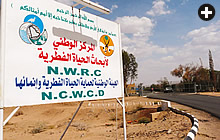 |
| MATTHEW TELLER |
| In Saudi Arabia, the National Wildlife Research Center in Taif is part of the National Commission for Wildlife Conservation and Development, which directs the national oryx conservation programs. |
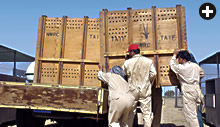 |
| NWRC |
| Oryx are transported to protected areas in specially made crates. |
This pride, however, is tempered with contempt for poachers. “The person
who is weak inside, who doesn’t understand the oryx—he is the hunter,” says Shaykh Mirbih.
Hunting has been outlawed by governments from Oman to Jordan. But enforcement remains patchy, and hunting remains deeply embedded in Arab culture. Robinson questions the effectiveness of hunting bans. “It might have been more profitable to educate hunters, to try to integrate hunting into conservation,” he says.
Othman Abd ar-Rahman Llewellyn, an environmental planner with the ncwcd and a specialist in Islamic conservation, agrees that “by working with the hunters we could develop a new ethic.” He points out that the 16th-century jurist Ibn Nujaym established a principle of Islamic law that declares, “Hunting is permissible, except for sport,” a term he defines as “a matter of intent.” Llewellyn has gone so far as to suggest that religiously sanctioned trophy hunting could generate funding for conservation.
This last idea reflects a worldwide shift as conservationists move beyond
narrowly focused protection of “flagship species” —oryx, pandas, tigers and such—toward protection of whole habitats, often with hundreds of species, using “socially inclusive” methods that help rural human communities maintain viability alongside wildlife. In many places, the most powerful tool in this new paradigm’s kit is ecotourism. In that field, where conservation meets commerce, the grandest schemes in the oryx’s future are being laid in the United Arab Emirates.
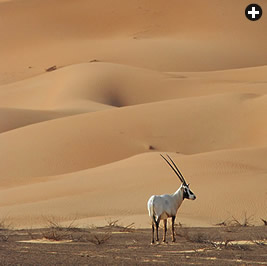 |
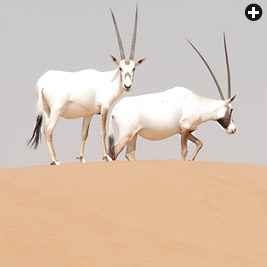 |
| Left: Some 150 oryx now inhabit the Umm al-Zumul sanctuary in the southern corner of the United Arab Emirates, where, later this year, tourists will be able to go on oryx safaris, earning more than a few of the country’s oryx-bearing 50-dirham notes, above-left, for conservation programs. Right: Cautious but habituated to humans, oryx on a dune at the Al-Maha Desert Resort observe a photographer. |
Dunes piled in every shade of apricot and ochre, divided by immense salt flats, cover an area only slightly smaller than Lebanon and two and a half times the size of Rhode Island: This is the Umm al-Zumul reserve, 300 kilometers
(186 mi) south of Abu Dhabi. Here, Abu Dhabi’s Environment Agency released some 98 oryx in 2007. With natural growth, they now number around 150. Another 95 are due for release early next year.
Northeast of the reserve, the city of Al-Ain hosts the largest zoo in the entire Middle East. It is here that oryx are raised for release. “A lot of zoos around the world breed animals with no goal,” says Mark Craig, former director of the zoo. “But we have one oryx population on display and another ‘back of the house,’ maintained specifically for reintroduction. They have a different diet, closer to what they’d get in the wild—less protein, less availability of water.”
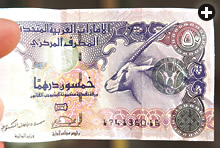 |
| MATTHEW TELLER |
| The country’s oryx-bearing 50-dirham notes. |
The goal, he says, is “a bit of both” conservation and ecotourism commerce, the latter fueled by two luxury resorts built by Abu Dhabi’s Tourism Development and Investment Company. Along the coast, the Desert Islands project, launched late last year on Sir Bani Yas Island, offers a modest wildlife park (35 km2, 13.5 sq mi) holding 400 Arabian oryx along with fauna from giraffes to dugongs.
Near Umm al-Zumul, the Qasr al-Sarab (Mirage Palace hotel) is due to open late this year, offering oryx safaris. However remote it may seem, Umm al-Zumul is a model of a managed—even manicured—wilderness.
The Environment Agency has gone so far as to plant an entire forest of arrak trees (Salvadora persica) to provide food and shade for the oryx—essential in an area recording highs of 62 degrees Celsius (144°F). Nearby, I saw a herd of 60 or 70 gazelle—from the reserve’s total population of more than 3000—grazing on irrigated lawns. Elsewhere, rangers dropped alfalfa for roaming oryx and fed bottled milk to abandoned oryx calves. Drinking water for the oryx will be trucked from a solar-powered desalination plant built by the agency on the shores of an artificial lake.
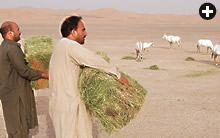 |
| Rangers feed their charges at Umm al-Zumul, which, like other sanctuaries, offers managed conditions designed to resemble wild habitats. |
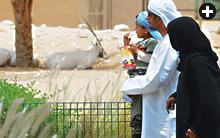 |
| The Al-Ain Zoo displays oryx and also maintains a population out of public view for future reintroduction to the wild. . |
The growth in Gulf tourism has turned the oryx into a business tool. How sustainable is the future this offers?
The question is already being addressed in the neighboring Dubai emirate at the Al-Maha Desert Resort. (Maha is Arabic for oryx.) Located within the Dubai Desert Conservation Reserve (DDCR) and open since 1999, the resort has won awards for the sensitivity of its design and its conservation ethic.
In November 2008 the International Union for the Conservation of Nature granted the DDCR ”Protected Area”
status—the only example in the Middle East (and perhaps the world) of a conservation scheme of global scientific value emerging from a commercial tourism project. Greg Simkins, DDCR’s conservation manager,
is proud of the achievement. “Serious conservationists now say this [profit-based] model could be utilized in
different parts of
the world.”
Indeed, on one drive through the grounds, herds of 20 or 30 oryx skittered over the lightly vegetated dunes, their horns crisscrossing against the sky. It was more oryx together in one place than I’d seen anywhere else. Yet there was another side to this coin. Though their habitat was natural, the animals’ behavior was not: Like lions in a safari park, the oryx meandered across the paved paths between chalets as if tame, munching at the foliage unfazed as electric golf carts ferried guests to and fro.
Does giving humans a close encounter with wild animals justify confinement, if that changes the animals’ behavior? Does saving a wild animal from extinction justify confinement, if that makes it less wild? These questions apply not only to Arabian oryx, but also to tigers in Rajasthan, dolphins in Florida
or, for that matter, creatures in any zoo in the world. And as usual, there are no
easy answers.
Conservationists have faced the choice of either limiting the oryx’s natural range—a daunting several thousand square kilometers per herd—in order to guarantee the animals’ survival, or allowing them to roam under threat of extinction. At Al-Maha, as almost everywhere, fences have proved to be the lesser of two evils.
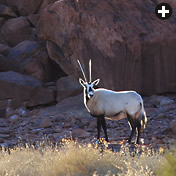 |
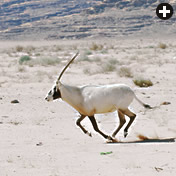 |
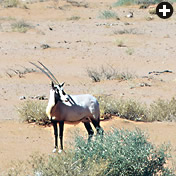 |
| Though southern Jordan was once part of the oryx’s natural range, conservationists say the introduction of oryx early this year in the Wadi Rum Protected Area—where each of these three photos was made—will test the continued suitability of the popular tourist region as oryx habitat. |
In more densely populated Jordan, 20 satellite-collared oryx were released this year into Wadi Rum, one of Jordan’s most popular tourist regions, by the Aqaba Special Economic Zone Authority (ASEZA) in partnership with Abu Dhabi’s Environment Agency. Conservationists will work with Saudi counterparts to “repatriate” any oryx that wander south over the border. The second batch of 20 is due to arrive early next year.
Significantly, ASEZA is embracing the model of conservation-through-commerce. Yehya Khaled, director of Jordan’s Royal Society for the Conservation of Nature, gives a hard-headed analysis: “The Bedouin will hunt the oryx to sell if we release without their ownership and support. And if we try to release in Jafr [a remote site, far from tourist routes], the oryx will be lost, as in Oman. But in Wadi Rum it’s easy to create ownership: The people see the oryx as an asset. Keeping an oryx alive will bring them more income than if they kill it or sell it.”
In Wadi Rum, I found broad support for the project—not least because the area’s 1200 people earn their livings almost entirely from tourism. Yet Wadi Rum is far from an ideal oryx habitat, and whether the animal will thrive or not, even with all these efforts, is yet to be seen. In Abu Dhabi, conservationists identified oryx habitats, and then developers created attractions within them, thus bringing tourists to oryx. In Wadi Rum, by contrast, Jordan is shoehorning a reintroduction project into an existing attraction, bringing oryx to tourists.
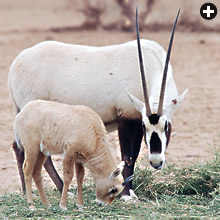 |
| An oryx and her calf feed on alfalfa at the Shaumari Wildlife Reserve in central Jordan. |
Half a world away, there may be a useful analogy in North America, where as many as 60 million bison once roamed the continent’s plains. Uncontrolled hunting in the 19th century reduced their numbers to a few hundred and put their survival in doubt. From 1889, captive-breeding and reintroduction programs, along with changes in hunting behavior, laws and ethics, allowed the species to regain a foothold. Today, there are more than 300,000 bison, most living on combinations of protected and private ranges. Some areas have recently begun issuing permits for hunting in order to maintain balanced populations, and bison are now also widely raised for meat. Though their days of free ranging have gone, it has still been possible to restore the animal to a mostly sustainable habitat within a new economic and conservation framework.
Today’s pan-regional programs, despite their challenges, actually make such a future for the oryx relatively easy to imagine: With increasing international cooperation, oryx reserves can network with each other; ranch-style reserves can breed oryx for hunting under permit controls; educational reserves can showcase oryx for students; and tourist reserves can allow visitors to experience Arabian culture and wildlife in natural settings.
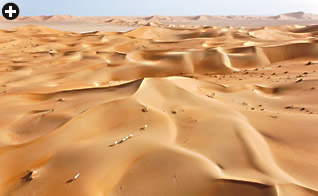 |
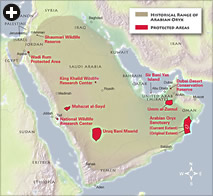 |
| Left: GEORGE STEINMETZ |
| Although managed habitats such as this part of the Arabian Oryx Sanctuary in Oman look wild, the oryx’s future will require increasing resources of time and money for research, field data collection, assessment, intervention and enforcement of anti-poaching laws, as well as for maintenance of balanced relations among humans, oryx and other species. |
In this direction, it may be that the most hopeful sign, paradoxically, is the past
catastrophe in Oman on the Jiddat
al-Harasis, which demonstrates that, more than ever, social inclusion is essential to wildlife conservation. And in that respect, it is ubm that today stands out as the one project that checks all the boxes. Robinson confides that “coming from South Africa, where tourism is essential for conservation, I’m very pleased to be in Saudi Arabia, where tourism isn’t essential for the oryx, and where there is nonetheless governmental willingness to fund protected areas like Uruq Bani Maarid.”
The baton for a sustainable future for the oryx has passed, for now, into Saudi hands.

Tourism has become essential as a means of funding oryx conservation—as well as garnering prestige—but under truly wild conditions tourists would have to drive for days into the desert to view oryx, perhaps seeing the naturally shy and skittish animals only as white specks in the far distance. So an enclosure is created in order to give the tourists a relatively quick and easy oryx-spotting experience. But penning the animals distorts the science of conservation: Although oryx can survive without water, gaining moisture from the plants they eat, fences limit their access to such plants. So scientists must then provide water to ensure the oryx’s survival. But drinking fresh water alters the balance of electrolytes within the oryx’s body. In nature, they would roam to find mineral-rich foliage to compensate, but behind fences they cannot. So they must be supplied with artificial salt licks—and the problems multiply. Tourism demands a wild, or near-wild, experience, but it also creates a spiral of more and more intensive management merely to maintain the semblance of wild conditions.
Yet “free ranging” is a key point in international guidelines on reintroduction. Oryx can smell rain from enormous distances, and a barrier will, sooner or later, thwart their natural instincts to move toward it. “Mahazat al-Sayd, even though it’s 2244 square kilometers [866 sq mi], is clearly not big enough,” Robbie Robinson told me. “You get a number of years when there’s no rain anywhere in there, so the oryx try to migrate—and get stopped by the fence.”

Classified as one of the ungulates—that is, hoofed mammals that carry their weight on the tips of their toes, including horses, cattle and sheep—the Arabian oryx (Oryx leu-coryx) is a white antelope with a desert range that once covered much of the Arabian Peninsula as well as the Levant and Iraq. It has several related African species that, though larger and darker, also inhabit arid zones. These include principally the gemsbok (Oryx gazella) in the Kalahari of southern Africa, the beisa (Oryx beisa) in eastern Africa, the scimitar-horned Oryx dammah in the North African Sahara and the addax (Addax nasomaculatus) of Libya and Algeria.
Surprisingly slight—weighing only around 70 kilograms (154 lb) and barely more than a meter (39") tall at the shoulder—the Arabian oryx is well adapted. Its white coat reflects the sun, helping it survive in some of the most extreme heat on Earth. In the wild, oryx endure months without drinking, instead absorbing moisture from the plants they graze. They are unaggressive, and their herds average 10 or 15 animals.
Bedouin have long attributed to oryx qualities of stamina, toughness, loyalty and self-discipline, and this legacy is articulated in early Arabic poetry. The ninth-century Baghdadi poet Ali ibn al-Jahm wrote of the oryx’s almond-shaped eyes in a famous work sometimes entitled Ayoun al-Maha (Eyes of the Oryx):
The eyes of the oryx between Rusafa and Jisr
Spark desire from a place I know – and a place I don’t;
They restore old love to me, even though I did not forget,
Yet they fuel my fire with more fire.
Although Rusafa and Jisr refer to bridges across the Tigris in Baghdad, they also have metaphorical meanings linked to yearning.
Zuhayr bin Abi Sulma, in the sixth century, lyrically describes a female oryx with eyes “ringed with kohl,” horns “smooth and sharp,” successfully repulsing dogs and hunters. It was also Zuhayr who first used the oryx to symbolize human dignity, a
motif popular among later poets. In the classic Arab tradition of story-within-a-story, a tribe in difficulty would send a poet to a neighboring tribe, where he offered a dramatic account of an oryx hunt, full of idealized language and symbolic meanings, which would end with the hunted oryx seeking sanctuary in a place of comfort and refreshment. “In this way,” explains Ahmed Boug, director of the National Wildlife Research Center, part of Saudi Arabia’s ncwrc, “a tribe could ask for help from its neighbors without actually having to ask.”
This poetic connection survives in modern Arabic, where the standard word for oryx, al-maha (also a common woman’s name), has several flamboyant synonyms, including al-wudaihi (“bright one”), baqar al-wahsh (“wilderness cow”) and ibn sola (“child of beauty”).
Today, businesses from media consultancies in Kuwait to fuel retailers in Oman use the oryx name or logo to associate themselves with dignity, fortitude and an essentially Arab identity. In Qatar, the oryx is the national animal: It adorns Qatar Airways aircraft tails, and a cartoon oryx was the promotional mascot of the 2006 Asian Games in Doha, where the athletes’ torches were shaped like oryx horns.

Shy, elusive, brilliant white and often seen only from a distance, the oryx certainly has two horns, slender and curved. But they can seem to merge into one when the animal is seen in profile, and that was apparently enough for Aristotle: “There are some [animals] that have but a single horn: the oryx, for instance,” he wrote in the fourth century BC.
The idea endured, often mixing classical bestiaries with Arabic hunting poetry. The unicorn hunts of medieval European authors were noble, high-status pursuits that paralleled the prestige attached to oryx-hunting in the tales of the early Islamic period. Where Arab authors wrote of hunted oryx seeking refuge in caves and other natural hideaways, Europeans depicted hunted unicorns seeking refuge by resting their heads in the laps of maidens. The Bible several times refers to a horned animal of great fortitude named reem (or re’em) in Hebrew, and many commentators believe that this refers to the oryx: In modern spoken Arabic, reem means “gazelle,” but dictionaries of literary Arabic define reem as “white antelope.” And most curious of all, the translation of reem in the 1611 King James Version of the Bible is simply “unicorn.”

These are links to content outside www.saudiaramcoworld.com. While we make every effort to link only to quality third-party Web content, Aramco Services Company is not responsible for the veracity of such content, nor does linkage imply endorsement of any views expressed by that content’s authors.
 |
Matthew Teller is a free-lance journalist and travel writer based in the UK. He has published widely on the Middle East, including for CNN Traveler and The Times of London, and is the author of several guidebooks. For this, his first Saudi Aramco World assignment, he visited 10 oryx reserves in four countries. His website, www.matthewteller.com, links to his blog, Quite Alone. |
 |
Bill Lyons (www.billlyons.com) lives in Amman, where he has photographed regularly for Aramco World, Saudi Aramco World and other editorial and corporate clients for more than two decades. |





